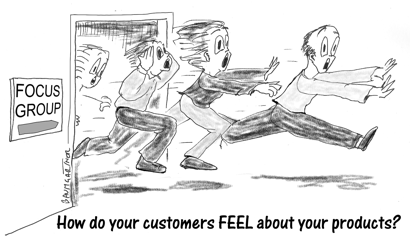
Innovation Has Feelings
By Jeffrey Baumgartner
The word, "businesslike" implies a lack of emotion or feelings. To say, "she has a very businesslike approach," implies that she is logical, profit-oriented and unemotional. Indeed, many of us would like to think we leave our feelings at home when we go to work; that we operate efficiently, productively and do not let anything as troublesomely unbusinesslike as feelings to get in the way of our work. But, of course, that's ridiculous! We as human beings are emotional, feeling creatures. We cannot help to bring our feelings to work and allow those feeling to affect us. Likewise our colleagues, customers and business partners have feelings which affect their behaviour, preferences and decisions.
Innovation has feelings too − or at least is should have if we want it to succeed.
Before You Think About Innovation
Before you start thinking about ideas for a new product, process or other activity, think about the feelings associated with the subject of innovation. If you intend to launch an updated product, do not limit your thinking to functions and features. Think also about how you really feel about the product now and how you would like to feel about the product once the innovations have been applied.
To give a worst case example: years ago I was employed by a company where I felt vaguely embarrassed by the product − and I know many of my then colleagues felt likewise − but I would have liked to have felt proud of the product and I would have liked to have felt proud to be employed by the maker of that product. Sadly, management there preferred risk-free mediocrity over innovation. I did not stay there long.
Product Innovation
If you are planning to launch a new product or revive an existing one, ask yourself and the team how you feel about the existing product. And be completely honest. It is important to identify negative feelings − so you can do something about them − as well as positive feelings and even ambivalent feelings. Then ask how you want to feel about the product.
What about your customers; how do they feel about your product? Do they love it? Do they take pride in ownership? Do they identify with it? Or do they buy it because it is cheap and readily available in Aldi or Carrefour or Wal-Mart or Kmart? Be honest here. You may need to commission a little research here to find out the truth.
How do you want them to feel about your product? Should they be delighted with it? Should they feel it is cute? Should they feel a little special as owners of your product? Perhaps they should feel more intelligent or more fashionable or more pragmatic for owning your product.
Apple is a good example of a company that takes advantage of their customers' feelings towards their products. You could argue with an Apple fan till you were blue in the face that a particular Samsung phone is technically superior to a similar iPhone, but you would never convince her. Although both companies make excellent telephones, Samsung products simply do not excite the kind of feelings that Apple products do. For Apple, that's great. They can add a surcharge to their product and, if something goes wrong with a new product, customers are more forgiving.
Even Toyota, which seems a rather dull brand on the surface, evokes feelings in their customers. Toyotas are known for reliability and functionality. They are not performance cars, but customers feel they can trust their cars not to break down and not to surprise them. Trust is a good feeling to provoke in your customers.
Feelings Before Ideas
If you want customers to have particular feelings about your product, you need to start thinking about these feelings even before you start thinking about ideas − indeed feeling questions are a part of the anticonventional thinking process. Once you are clear on how you want your customers to feel about your product, consider how they really feel about your products now. Only then can you think about how you could innovate your product to start evoking the desired feelings. But bear in mind that unless you are a new start up launching your first product, this will take time.
Years ago, Audi were considered rather dull German saloon cars. They were slightly upmarket Volkswagons that were functional, reasonably reliable and dull. In the 1980s, Audi developed a four wheel drive performance car called the Quattro which became a rallying success. Not long after that, they began using the German phrase "Vorsprung durch Technik" (translation: advancement through technology) in their global advertising. The use of German in the slogan was particularly clever as German engineering quality has an excellent reputation globally. And German just sounds industrially sound.
At the same time, Audi began introducing more and newer technology to their cars, which pushed them into a higher market segment. In the 1970s and early 1980s, no one would likely feel excited about an Audi. Today, Audi owners take pride in owning well engineered, sophisticated German cars. But it took some years, plenty of investment and a focus on the new image to achieve this.
If your company is a well established one that produces good products that no one gets very excited about, you can change that. But it will take time and an innovation focus.
Negative Feelings
Perhaps the only thing worse than customers feeling ambivalent about your products is customers having actively negative feelings about your products. This typically happens for one of two reasons, either your products are of notoriously poor quality or your corporate image has problems. We'll get to the second point in a few paragraphs.
If your company produces poor quality products, the very first thing you need to do is improve quality. There is no point trying to get customers to take pride in owning your bookshelves (to give an example), if your bookshelves are notorious for falling apart within six months of ownership.
Once you have tackled the quality issue, then you can tackle the feelings.
Samsung is a good example of a company that once produced poor quality products, but changed. In the 80s and early 90s, Samsung electronics were perceived as cheap, low quality items. They were not well built and broke easily. However, in the 1990s, the company repositioned itself and aimed to raise its level of quality and functionality to that of Sony and other Japanese brands which were generally considered the best in terms of quality for money.
Today, Samsung may not evoke much emotion in their customers − but that is surely far better than the negative emotions Samsung evoked not long ago. And their products are of high quality.
Start-Ups Have the Advantage
Start-ups have the advantage when it comes to associating feelings with their products. Their products are new and are not encumbered by existing feelings. However, in their enthusiasm about their products, founders inevitably have far stronger feelings about their products than do their customers.
Nevertheless, how you want customers to feel is a critical factor to consider if your new company is launching a new product. You should be careful to be original here. Do not try to emulate the feelings people have about an existing product or you will be perceived to be a copy-cat and will always be in second place at best. Instead, identify your own emotional identity and exploit it in your innovation from day one. It is a powerful way to cement your brand identity as well as define an innovation focus for the future.
How Does Your Product Feel?
Once you have worked out how you, your colleagues, your business partners and your customers feel about your product, think about how you would like your product to feel about your customers. This is a great exercise for creativity.
If you are designing a mobile phone app, think about how you want it to feel towards end users. Is it serious and businesslike? Is it aggressive (such as in a game)? Is it friendly? Is it formal? This is a route I like to take in creativity workshops. Once a team decides that their product will be businesslike with a sense of humour, it becomes a lot easier to build a cohesive creative vision of the new or revived product.
People Have Feelings About Processes Too
If you think your colleagues do not have feelings about processes, just try changing a process in your organisation and observe the reaction. Occasionally, people will be delighted that an inefficient and outdated process has been updated or changed all together. But more often than not, you will find that people are emotionally attached to processes − and they don't want those processes changed.
Consider the initial response you inevitably hear when talking about changing a process that affects customers: "Our customers won't like it." Of course, that usually means that the person commenting on the change does not like the idea.
Indeed, this will be your biggest challenge in introducing new process ideas in your organisation: your colleagues will not like the idea. It will make them feel unhappy and, as a result, they will criticise the idea.
Worse, they will often criticise the idea for all the wrong reasons because they know that to say, "I do not like this idea, it makes me unhappy to think about it being implemented," is unbusinesslike. Instead they will criticise details in the idea.
This is too bad. Because it means that the team responsible for developing the process innovation will waste time addressing the wrong complaints and fail to address the true complaint.
On the other hand, if you acknowledge from the beginning that your colleagues will not like your process innovation idea, then you can address the feelings early on. That will help you gain internal support for the innovation and ensure that its implementation runs smoothly.
People often do not like process innovation for these reasons.
- They feel comfortable with current processes that they understand. It is
rather like threatening to take away someone's favourite armchair (or sofa)
and replace it with a different, unknown armchair.
- Change which affects them, but over which they have no control, makes
them feel uncomfortable and insecure. As a result, they worry about their
jobs. What new skills will they have to master in order to apply the
process? What will they have to learn? Will they be competent in the new
skills? In a worst case scenario, they may worry about losing their jobs.
- The new process introduces uncertainty. Will it take more time? Will it require new technology? How will the transition work? What happens if I cannot master the new process?
Addressing these issues and other feeling issues from the ideation stage will make all the difference in how successful you are in implementing your process innovation.
Corporate Image
You may not think much about corporate image innovation, but you probably should. Unless your company is an obscure maker of commodities, your customers having feelings about your corporate image and that is something you should at least evaluate and most likely address.
Some companies have poor corporate images which lead to negative feelings about the brand, the company and the products. This is particularly true in markets in which people do not have much choice. Tobacco is a good example. Today, few people have a positive image about any tobacco company. However, since smoking is addictive and the world still has millions of smokers, tobacco companies can sell their products without worrying too much about how their customers feel about them − particularly as people tend to feel negative about the industry as a whole.
Nevertheless, this does produce some problems. For example, tobacco companies can find it hard to hire talented people simply because talented people have a choice of jobs and many of them find the idea of working in a tobacco company undesirable. Indeed, I was once hired by a tobacco company to teach them how to creatively address this issue though anticonventional thinking.
To a lesser extent, the negative feelings about corporate image also applies to sectors such as telecommunications, oil and finance. Most people dislike their telecommunications providers but feel trapped because theres limited competition in their region and the alternatives are no better. As a result, customers choose a particular telecoms provider not out of love, but based on pragmatic issues such as price or performance. If ever a telecoms provider made a successful effort to be a likeable, desirable organisation, I expect they'd be a tremendous success.
Ethics and Accidents
Sometimes poor country image comes from bad behaviour. In 1973, the book The Baby Killer accused Nestlé of promoting their milk products over breast milk in developing countries. As a result, impoverished families were spending money on unnecessary infant milk powder rather than free and healthier breast milk. To make matter worse, many developing countries did not (and do not) have safe drinking water and uneducated mothers did not understand the importance of sanitation and, unable to read, could not even get the information from the packaging. As a result, Nestlé was perceived as endangering babies in developing counties and, understandably, that did not make people feel good about the company. The result was a global boycott and negative feelings about Nestlé that continue, albeit at a much smaller level, today. (You can read more about this on Wikipedia).
Damage to corporate image can result from perceived bad behaviour, as is the case with Nestlé, as well as because of accidents, such as BP's relatively recent oil spill in the Gulf of Mexico.
When this kind of thing happens, you need to act quickly to salvage your brand reputation and this requires thinking about how people felt about your firm before the bad event, how people feel now and how you want them to feel. Indeed, I would argue that your second priority, after fixing any damage, is to work on the public's feelings about the corporate image.
The best example of saving brand image and even developing positive feelings as the result of a disaster was the infamous Tylenol murders of 1982. Someone (to this day, no one knows who) put cyanide into Tylenol pain reliever capsules before they were delivered to shops in the Chicago area. Seven people, including a 12 year old girl, took the capsules and died.
Not surprisingly, this hit the news big time. Fortunately, Johnson and Johnson, the manufacturer of Tylenol acted quickly by removing all of their Tylenol products off all shelves across America − even though it seemed the poisoned capsules had only been distributed in the Chicago area.
By acknowledging that there was a serious problem and taking quick action that cost them millions, Johnson and Johnson, demonstrated that they cared about their customers and were willing to take the financial hit and responsibility for this tragedy.
In spite of horrific publicity, Johnson and Johnson's corporate image was initially only minimally damaged by the incident and, over the longer term, probably benefited by their response. Indeed, their action is a business school case study, in how to respond to disasters, in many universities.
Using Feelings Helps You Innovate
If acknowledging, understanding and using feelings is not a part of your innovation process now, change that. Even before you start working on ideas for a new product, service or process, ask questions about how all the stakeholders feel about the product, service or process. Then go one step further and think about the feeling that the product, service or process might have now and the feelings you would like it to have.
Once you have an understanding of all the relative feelings, this should become a factor in all of your innovation. If, for example, you've decided your company makes fun products, then always include fun in your ideation and implementation.
In the event, something happens to damage your company's brand image, respond immediately to fix the situation and then focus on the feelings of your customers and the public to the situation.
I assure you that you will feel good by doing so!
Recent Articles
Leading Diverse Teams
Filed under: Business Innovation
Diverse teams are more innovative and smarter than homogeneous ones. But, they are also harder to manager. Here are some tips. By Jeffrey Baumgartner -- Read the article...
Questions you should ask when an innovative project fails
Filed under: Business Innovation
You can learn a lot from the failure of an innovative project, but you need to ask the right questions. Here are those questions. By Jeffrey Baumgartner -- Read the article...
Unmarketing the Competition
Filed under: Business Innovation
A look at creative, but unethical dirty trick marketing campaigns designed to damage the competition By Jeffrey Baumgartner -- Read the article...
Imaginativefulness and the Fisherman
Filed under: Creativity
What does a fisherman wearing a cycling helmet have to do with imaginativefulness? Quite a lot, it seems. By Jeffrey Baumgartner -- Read the article...
Actually, Criticising Ideas Is Good for Creativity
Filed under: Creativity
People have long assumed criticising ideas in a brainstorm inhibits creativity. Research and experience shows that is wrong By Jeffrey Baumgartner -- Read the article...
Imaginativefulness
Filed under: Creativity
Imaginativefulness is a state of heightened imagination in which your mind allows thoughts, memories and ideas to play with each other freely. By Jeffrey Baumgartner -- Read the article...
Why and How to Exploit Alternative Uses for Your Products
Filed under: Business Innovation
Discovering new ways customers use, misuse and could use your products can inspire innovation. Jeffrey Baumgartner explains. By Jeffrey Baumgartner -- Read the article...
The Cost of Not Innovating
Filed under: Business Innovation
If your company fails to innovate, you pay a steep price in terms of loss of leadershop, tight margins, missed opportunities and more. By Jeffrey Baumgartner -- Read the article...
Don't Trust the Status Quo
Filed under: Creativity
Jeffrey Baumgartner has never trusted the status quo. He explains why this is so and why you should also not trust the status quo By Jeffrey Baumgartner -- Read the article...
Index of all creative articles...




